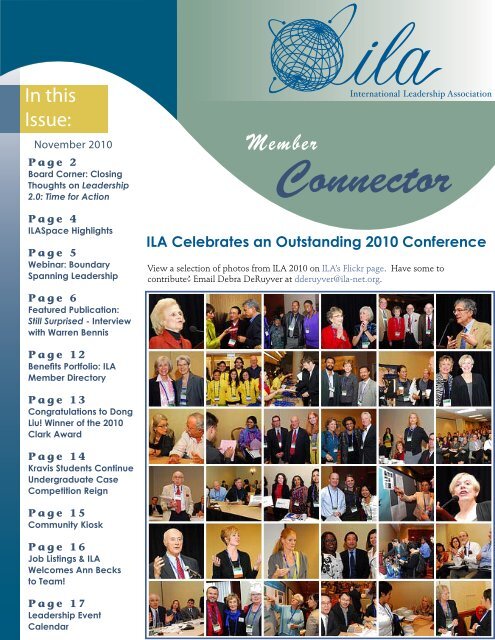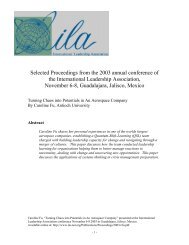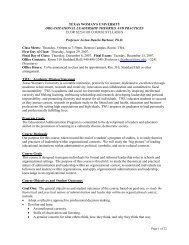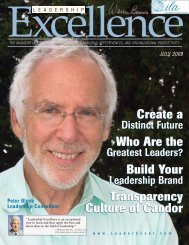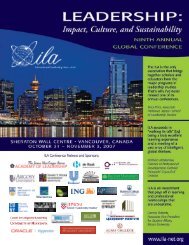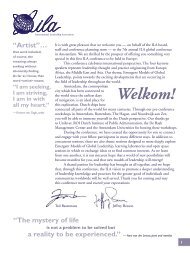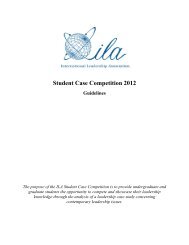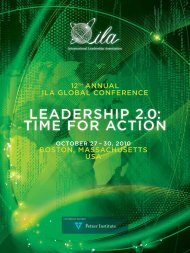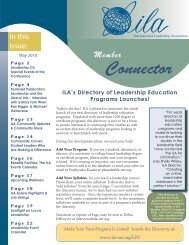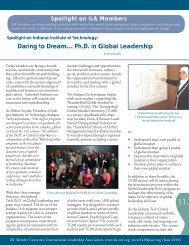Connector - International Leadership Association
Connector - International Leadership Association
Connector - International Leadership Association
Create successful ePaper yourself
Turn your PDF publications into a flip-book with our unique Google optimized e-Paper software.
In thisIssue:November 2010Page 2Board Corner: ClosingThoughts on <strong>Leadership</strong>2.0: Time for ActionPage 4ILASpace HighlightsPage 5Webinar: BoundarySpanning <strong>Leadership</strong>Member<strong>Connector</strong>ILA Celebrates an Outstanding 2010 ConferenceView a selection of photos from ILA 2010 on ILA’s Flickr page. Have some tocontribute? Email Debra DeRuyver at dderuyver@ila-net.org.Page 6Featured Publication:Still Surprised - Interviewwith Warren BennisPage 12Benefits Portfolio: ILAMember DirectoryPage 13Congratulations to DongLiu! Winner of the 2010Clark AwardPage 14Kravis Students ContinueUndergraduate CaseCompetition ReignPage 15Community KioskPage 16Job Listings & ILAWelcomes Ann Becksto Team!Page 17<strong>Leadership</strong> EventCalendar
Closing Thoughts on<strong>Leadership</strong> 2.0: Time for ActionKatherine Tyler Scott, ILA Board MemberBoardCORNERKatherine Tyler Scott shares her thoughtson the conference, Saturday October 30.Hasn’t this been a wonderfulConference? I just met someone onthe elevator today who said, “Myhead is full, my heart is bursting, andmy feet are tired.” I think we canall relate to this description at thispoint. Each of us has a perspectiveabout what we have experiencedhere and what it means; I feelprivileged to share mine.We all know that ILA is aunique organization of scholars,practitioners, and educators whoall share a mission of promoting adeeper understanding of leadershipknowledge and practice forthe larger good of individuals,organizations, and communitiesworldwide. What this conferencehas inspired us to do is to reinterpretthis mission in light of thecurrent reality and our desire for adifferent future.In [2010 Conference Chair]Sherry Penny’s warm and2.gracious welcome andChancellor Motley’s energeticinvitation we heard both pridein this “City of firsts,” as well asacknowledgement of the challengeof being a place of tradition andinnovation.Our President, Cynthia Cherreyprovided a context for our timetogether and for <strong>Leadership</strong> 2.0. Shedescribed a state of chronic shiftsand a degree of change that calls usto think differently and to developand use the skill of complex-ipacity.The issues we face demand adifferent way of leading, somethingwe’ve heard daily. Every speakerwe heard in our Plenary Sessionsas well as many workshop leadershave shared this appraisal as wellas their own thoughts about whatthis means for leadership study andpractice, and for us individually andcollectively.<strong>Leadership</strong> 2.0is <strong>Leadership</strong>1.0 onsteroids!—acall to action,persistentlydemanding theanswer to thequestion posedby both JeanLipman Blumen[a 2010 LifetimeAchivementAward Winner]and [keynotespeaker]Rosabeth Moss Kanter—“<strong>Leadership</strong> for what?”Karen Armstrong, winner of a 2009 TEDprize for her work, gives her keynote,“<strong>Leadership</strong> 2.0: Interfaith <strong>Leadership</strong> &Compassionate Action”The answers will come from all ofus and from our willingness to workacross boundaries and explore theintersections between what we arelearning and doing and betweenwho we are and what we believe.We must be willing to let go of theillusion of control, as Cynthia saidand be on what I describe as themargin.Ecologically, the margin is abiologically rich and diverse placewhere different habitats cometogether. In <strong>Leadership</strong> 2.0 these arethe spaces in which we can bring ourwhole selves; where we cannot andwill not permit professional, cultural,geographic, racial, ethnic, and/orreligious classifications to divide usor to perpetuate the illusion that wedon’t share a common humanityor the same fate. We are connectedand when we move from our placesof professional centrality to wherewe intersect, we find ourselves inthe space of great potential and awealth of possibilities for creatingchange that is trulytransformational.Being on the margingives us a senseof humility and arenewed respectfor differences. Itenables us to seefrom a distancewith clarity andcompassion— thekind that [keynotespeaker] KarenArmstrong spokeof —the kind ofcompassion that urges us to action.The margin is not a neat orderlyantiseptic place. It is organic andat times messy and unpredictable,but those who inhabit it understandthat it is the place from which thenew order will emerge. In order(November 2010) The Member <strong>Connector</strong>, <strong>International</strong> <strong>Leadership</strong> <strong>Association</strong>, www.ila-net.org, www.ILASpace.org
to achieve this new order ILA willneed to continue to be a space ofhospitality, where strangers canenter and discover themselves andexperience the freedom to be realand authentic, open and honest, likeevery single honoree who receivedthe <strong>Leadership</strong>Legacy awards.They personify<strong>Leadership</strong> 2.0.We mustcommit tocreating suchplaces andspaces forthose whoselives we touchand whom weteach. As HenriNouwen writes,“Most of us know from experiencewhat real hospitality feels like.It means being received openly,warmly, freely, without the need toearn your keep or prove yourself…ahospitable spaceis alive with trustand goodwillrooted in a senseof our commonhumanity.”Jeff Swartz, President and CEO,Timberland, gives his keynote talk,“<strong>Leadership</strong> 2.0: Action in Service to thePlanet and Its Citizens”Of coursewe must beaccountable;assessment iskey, but we mustalso be counter to the culture. Wemust not accommodate distortionsor mistruths. We must engageothers in doing their inner workand in aligning their values withtheir actions, and enabling themto exercise their gifts in order tobring about the transformation weenvision. Jung reminds us that “wholooks outside, dreams; who looksinside, awakens.” We must awakenourselves to our inner potential anduse it to bring about external change.U-MASS Boston Chancellor J. KeithMotley Welcomes ILA 2010 to BostonMichael Jones, who has sharedhis gift of music with us, says thiseloquently in his beautiful book,Artful <strong>Leadership</strong>: “We must awakenourselves to our inner patience anduse it for external change. When aleader leads from their gifts theywill seek to temperpower with beauty,accomplishment withhumility, and actionwith reflection. In thisway they may find thefaith to engage theirworld with fresh eyesand ears each day.”The answer tothe question of“<strong>Leadership</strong> for what?”is yet to be answered.The answer to whatour leadership in action will be willnot be answered in this Conference ,but the answer, as [keynote speaker]Jeff Swartz said, is in our hands.I will end with oneof my favorite quotesfrom George BernardShaw: “Life is nobrief candle to me. Itis a sort of splendidtorch which we’vegot hold of for themoment and I wantto make it burn asbrightly as possiblebefore handing it ontofuture generations.”Like life, leadership is no briefcandle to us. It is sort of a splendidtorch which we’ve got hold of forthe moment and we want to makeit burn as brightly as possible beforehanding it on to future generations.When we convene in London nextyear we will all bring the torches ofchange for <strong>Leadership</strong> 2.0. for thenext generation.Vision: Transforming<strong>Leadership</strong> Knowledge andPractice Worldwide.Mission: The <strong>International</strong><strong>Leadership</strong> <strong>Association</strong> (ILA)is the global network for allthose who practice, study,and teach leadership. TheILA promotes a deeperunderstanding of leadershipknowledge and practices forthe greater good of individualsand communities worldwide.Our Commitment: Theprincipal means by whichour mission is accomplishedis through the synergy thatoccurs by bringing togetherpublic and private sectorleaders, scholars, educators,businesses, and consultantsfrom many disciplines andmany nations.Our Values: Inclusion:Nurtures and promotes broadand diverse membershipengagement; Intent:Encourages leadershipinitiatives that advancethe field of leadership andcontribute to the greaterglobal good; Interconnection:Builds upon the sharedinterests and complementarytalents of members to supportindividual and collective goals;<strong>International</strong> perspectives:Respects cultural contextsand facilitates learningand networking acrossnational boundaries;3.Integrity: Insists uponeffective and ethicalleadership practices andsound scholarship.The Member <strong>Connector</strong>, <strong>International</strong> <strong>Leadership</strong> <strong>Association</strong>, www.ila-net.org, www.ILASpace.org (November 2010)
Join the 460 other ILA members already on ILASpace as theyconnect on leadership questions and issues!• Connect your ILASpace account to Facebook, Google, or Yahoo!: ILASpace users may now signinto ILASpace using their Facebook, Google, or Yahoo! accounts. To connect your ILASpace profileto one of these accounts, navigate to your profile, then Settings > Connections. [Posted by Ashleyin Blogs]• A new group, <strong>Leadership</strong> Coaching, has been formed. In this group, Leslie Schwartz started adiscussion on “An Emerging Coaching 2.0 Paradigm” and wants to hear about your experiencewith different coaching models and programs.• Take a Quick Survey about Undergraduate <strong>Leadership</strong> Education. You’re invited to complete asurvey to contribute to a study which will identify the most frequently used instructional strategiesand most emphasized learning goals by leadership instructors such as you. [Posted by Dan Jenkinsin Forums]•“What do you see as the difference between a business curriculum that offers coursework in ethicsand a business curriculum that is built around an ethic of self-awareness, intentionality, and doingwhat is right?” Share your thoughts in response to this forum. [Posted by Richard Szwaja in Forums]• “How does authenticity and emotional maturity support the profound shifts in leadershipneeded for the 21st century? Share your thoughts in response to this forum topic. [Posted by LauraMack in Forums]• Have a cogent article, study, or tidbit to share? Do so at the <strong>Leadership</strong> Library, a newgroup created to be a “collection of leadership articles, books, and other documents to share anddiscuss.”• Have you blogged about the Boston conference? If so, share your links! [Posted by ShellyWilsey]• Welcome our new ILASpace community members Ajay Tejasvi, Wendy Martin, LotharLiehmann, Deborah Hackney, Lily Benavides, Scott Graham, by logging in and posting on their wall!To view all new arrivals go to Members and sort by recently added.Have a leadership question or dilemma? Have an interesting resource to share or need help findingone? Use ILASpace, the online network exclusively for members of the ILA!4.ILASpaceGroups | Forums | Events | Blogs | CommunityLogin atILASpace.org(November 2010) The Member <strong>Connector</strong>, <strong>International</strong> <strong>Leadership</strong> <strong>Association</strong>, www.ila-net.org, www.ILASpace.org
Register Now for thisInformative WebinarThe most important challenges weface today are interdependent – theycan only be solved by groups workingcollaboratively together. For businesses,governments, organizations,and communities to solve modernproblems and realize new opportunities,leaders must think and actbeyond current group boundaries andidentities. Enter Boundary Spanning<strong>Leadership</strong>: the capability tocreate direction, alignment, and commitmentacross boundaries in serviceof a higher vision or goal.Boundary Spanning <strong>Leadership</strong>begins with a new understanding ofthe boundaries that confine and limithuman relationships, whether theybe vertical, horizontal, stakeholder,demographic, or geographic. It then outlines six key practices for leading at the nexus where groups collide, intersect,and link: Buffering, Reflecting, Connecting, Mobilizing, Weaving, and Transforming. And it leads to new possibilitiesand inspiring results that groups can realize together above and beyond what they can achieve on their own.Join this webinar to learn more about this new leadership model, recently published by McGraw-Hill Professional andthe Center for Creative <strong>Leadership</strong> (November 2010) ,and to learn how to transform today’s limiting borders into tomorrow’slimitless frontiers to solve problems, create innovative solutions, and to transform your organization to thrive in aflat world. For additional information, please see www.spanboundaries.com.Chris Ernst is a senior faculty member in the Center for Creative <strong>Leadership</strong>’s (CCL) Organizational <strong>Leadership</strong> Practice.He previously served as Research Director, Asia-Pacific, with responsibility for the start-up of CCL’s Research andInnovation group located in Singapore. With a special interest on translating research-based ideas into modules, tools,and applications, Ernst has been widely published in articles, book chapters, and popular press. He is co-author of twobooks: Success for the New Global Manager: How to Work Across Distance, Countries, and Cultures (Jossey-Bass/Wiley) andBoundary Spanning <strong>Leadership</strong>: Six Practices for Solving Problems, Driving Innovation, and Transforming Organizations. Ernstholds a Ph.D. in Industrial and Organizational Psychology from North Carolina State University.Donna Chrobot-Mason is an associate professor in psychology at the University of Cincinnati and Director of theCenter for Organizational <strong>Leadership</strong>. Her work is focused on the intersection of diversity and leadership, with anemphasis on better understanding the challenges and opportunities that exist in leading a diverse workforce. Chrobot-Mason has been teaching courses in organizational psychology, diversity, and leadership for over twelve years. As aresearcher, Chrobot-Mason has presented at nearly fifty conferences, co-authoredfive book chapters, and published twelve peer-reviewed articles in journals suchas Human Relations, <strong>International</strong> Journal of Human Resource Management, Journal ofOrganizational Behavior, and Group and Organizational Management. She also serveson three editorial review boards for leading management journals.Learn more at: www.ila-net.org/webinars/#ErnstChrobotRegister at: www.ila-net.org/webinars/boundaryspanningleadership5.The Member <strong>Connector</strong>, <strong>International</strong> <strong>Leadership</strong> <strong>Association</strong>, www.ila-net.org, www.ILASpace.org (November 2010)
6.Featured Publication & Author InterviewStill Surprised:A Memoir of a Life in <strong>Leadership</strong>by Warren Bennis (Jossey-Bass, 2010)ILA Memberslogin atwww.ila-net.organd navigate to eBenefits--> Chapter Downloads toaccess the Prelude.This month, ILAmember RichardCouto continues inhis role as a specialguest interviewer.He is currentlyDistinguished SeniorScholar at Union Institute& University in their Cohort PhDProgram-Ethical and Creative <strong>Leadership</strong>.His most recent publication is thetwo-volume Political and Civic <strong>Leadership</strong>:A Reference Handbook (Sage,2010), which he edited.Warren Bennisis the foundingchairman ofUSC’s <strong>Leadership</strong>Institute,distinguishedprofessor of businessadministrationat the USCMarshall School of Business. One of theworld’s foremost experts on leadership,Dr. Bennis has written more than 30books and numerous articles on leadership,change and creative collaboration.His book Leaders was designated bythe Financial Times as one of the top50 business books of all time, and hereceived a Pulitzer Prize nomination forAn Invented Life. He has consultedfor many Fortune 500 companies andhas served as an adviser to five U.S.presidents. In May 2000, the FinancialTimes referred to Bennis as “theprofessor who established leadership asa respectable academic field.” ForbesMagazine referred to him as the “deanof leadership gurus.” In 2007, BusinessWeek named Bennis as one of the top 10most influential thought leaders.Richard: Great to have you today,Warren. We are talking aboutyour memoir Still Surprised.Could you talk about some of theother titles you considered foryour memoir?Warren: I’m usually very eager forfeedback about most things I do, Irequire it, I need it. At first I consideredonly one other title and finallydecided against it, based on feedbackfrom a person for whom I holdenormous respect: Howard Gardner.I was going to call it My Self throughOthers. I know my life has beenenriched and my development hasbeen through conversations, relationships,and connections I’ve had withothers. I don’t quarantine myselfand suddenly, “Eureka!”, a brilliantthought or idea comes to me. All ofmy learning comes through others—meaning that I thrive and grow andlearn through others, through conversation,through good questions. Oneof the ways I learn since I becameconscious of a Self, at Antioch Collegein the late 40’s, is dialogically: torepeat, with and through, others.Howard said, “No,” in thunder to“My Self through Others, and suggested“My Self-Discovery throughOthers,” which forced me to rethinkthe title. Suddenly, out of the blue,Still Surprised came to mind. I didn’twant to tell anybody because I didn’twant feedback from anyone: not a“No,” or a, “Hey! That’s wonderful.”I knew Still Surprised was right becausewhenever I try to be open anddiscuss my anxieties and insecuritiesand all the mistakes I’ve made, I’mrarely believed. They cannot suspenddisbelief and just think I’m anglingdiscretely for compliments. The truthis that I remain surprised, yes, stillsurprised at whatever success I’vegained and, more importantly, whateverbeloved connections I have.Most of the surprises you talkabout in the book are those youjust mentioned. But you talk aswell about aging in terms of surprise.Could you talk a little bitabout that?The chapter title is, “The Crucibleof Age,” and to me, it is the mostinteresting crucible because noone prepares you for it. If you’re awoman growing up in our society atleast early on you’re prepared for, aswell as angry and/or disgusted with,the sexism of everyday life. If you’rean African American or a womanor a Latino you go through experiencesearly on in your life that maybe hateful and ugly, if not dangerous.Frightful and scary as that is, you candevelop some pre-emptive defenseswhich at the very least, prepare you.But with aging, it’s more like havingyour first child. Who’s going to prepareyou for aging? Your body probablykeeps reminding you, but whatI’m getting at is that the two primaryimages we have of aging in our societyare extreme and wildly exag-(November 2010) The Member <strong>Connector</strong>, <strong>International</strong> <strong>Leadership</strong> <strong>Association</strong>, www.ila-net.org, www.ILASpace.org
gerated. At one extreme there is thefamous Bette Davis remark, “Old ageain’t no place for sissies,” which impliesaging is horrible. And the otherextreme is like those cruise ship TVcommercials where you see a seventy-ish-year-oldcouple: the guy witha nice, really a glorious, thick headof white hair and a tan, with Viagracoursing through his veins, and she,just gorgeous and voluptuous. Bothwith alarmingly white teeth andsmiling vigorously. The two of themhip-hopping around the dance floor,looking adoringly at each other. Wellthat’s all rubbish too. Aging is adventurousand rough in a sense thatI spend more calendar-coded time in“health maintenance”—visits to doctors,spinal surgery, walking twice aday, at least. Trying to keep in shape.It’s to keep an active sustained life.It’s work. Takes discipline. Even aftera full 6am-to-12 midnight day, remindingyourself to brush your teeth.I just saw a portrait of myself recentlytaken by Yousuf Karsh about 35years ago. He was a very famous portraitist,known for his photographicportraits of the rich and famous. Hehimself became a celebrity becauseof his portraits of celebrities. BecauseI knew his wife in college, he agreedto my portrait pro bono which wasto be placed in the Presidents’ diningroom when I was president of theUniversity of Cincinnati in the ‘70s.By the way, I’ve just learned that it’sno longer in sight anywhere becausethe curator of the gallery at USC hasbeen trying to get it “on loan” for aKarsh exhibit in her gallery. Then,Professor Selma Holo, USC’s curator,discovered that the portrait was notonly “in storage” somewhere, butnot in great condition: some gashesdisfigured the left side of my face. Irecently reviewed an email copy ofit, but apparently they’ve been unableto restore it. All the other portraitsof the past presidents were oilpaintings and they all looked alike:dour-looking old men. I wanted todo something different than thosegeneric, characterless oil paintings.Well, that’s what happens. That’swhy it is somewhere in storage at theUniversity of Cincinnati, which sayssomething about legacy doesn’t it?You would think that those peoplewho weren’t happy with yourtenure at the university would beeager to hang you somewhere!Hang me somewhere? Is that a laughline? Well, yes, probably. Can I readyou an email from Dr. Holo that justarrived today? She is also a friendand I think she is impishly carryingon this cartoonish correspondence.Well, here is the latest:“Hi Lucy, this is Selma…“ (Lucy isapparently the archivist at the Universityof Cincinnati.) “I imagine youwill be wanting to repair the portraitof your former president before lendingit out? You probably cannot displayit like that right? And of courseyou will be intending to display it,as he was one of your former presidents.Please advise what your plansare before we do loan forms.” ApparentlyLucy asked her to do somethingof a loan form because she wroteSelma and said “Oh! There seems tobe, it shows, oh, we do have PresidentBennis’s portrait and it is beingstored at the art museum. Attachedis a photo of it. In our records itshows there to be a crack in the leftcenter of the portrait. The crack canbe seen in the photo. I am copyingsomebody else who would preparethe loan agreement.” This goes on inthe correspondence. It is comedic,no?It speaks to that satisfaction atthe later part of life, looking backat these things and probably witha greater sense of humor thanyou might have had earlier.I don’t know whether it’s in thechapter, “The Crucible of Age,” orthe penultimate chapter where Iwrite about finally being given anhonorary degree at the University ofCincinnati in ’07. The President, atthat time a woman—a remarkablewoman, Dr. Nancy Zympher—delivereda great speech honoring me thatemphasized how much work I putin—two to three years of politicalenergy at least—to make the Universityof Cincinnati a state universityand, finally, financially viable. Mademe out to be a virtual savior. At thedisrobing room, after the ceremony,the Dean of the Faculty of Arts andSciences came over to me and said,“I had no idea that you had anythingto do with…” She was totallyvague about the whole “going state”campaign. She then continued tosay, “Your book, Why Leaders Can’tLead, page 21—I’ll never….” Andthen began quoting from an oldbook of mine, which to the Deanwas a “life-changing” experience.Talk about legacy: my voice, not myposition. Nothing about being thepresident, she didn’t even know Ihad been president until that day.And then there is the Karsh portrait.What’s weird and funny is that thedisfigured portrait is in storage somewhere,but my writing is all the gooddean knows about me. That doesmake me happy, actually becausetouching people with my writing andteaching is really what I care mostcare about.Talk a little bit about teachingthe leadership course at USC andwhy you find that so rewarding.You would think of all yourachievements there would be alot of things that would giveyou great satisfaction, butthis idea of gearing up semesterafter semester and dealingwith a set of new studentsis the thing that stands out foryou.7.The Member <strong>Connector</strong>, <strong>International</strong> <strong>Leadership</strong> <strong>Association</strong>, www.ila-net.org, www.ILASpace.org (November 2010)
8.I’m really glad you ask meabout that. I co-taught acourse for thirteen yearswith USC’s former President,Steven Sample. The course iscalled “The Art and Adventureof <strong>Leadership</strong>,” not, “TheArt and the Science,” by theway. The first few years wedidn’t know quite what directionto take and how we canorganize a semester-long courseabout a portmanteau topic likeleadership. Eventually, over theyears, the course began stirring upcampus buzz and the last semesterwe taught it, close to three hundredstudents applied for forty-twoopenings. The course had becometotemic on campus. In the last severalyears some students applied toUSC hoping to get admitted to thecourse when they were juniors orseniors.So over thirteen years five hundredor so students have taken the course.The students organized two reunionsover the years and over those weekends,hearing their stories about howwhat they learned has been incarnatedin their life stories. They comefrom all over the world, a few fromas far as Iraq and Uganda, for theweekend, on both occasions, combinedwith a football Saturday.One of the reasons teaching is sorewarding is that with first-rate,challenging minds, you just can’thelp learning. I know that soundscliché, but it’s really true. The secondreason I find the experience sorewarding is that in conversationswith my students, I feel I’ve becomea Master; not just good, not just anexpert, not just adept, not just veryconfident. That feeling of mastery isineffable. I don’t feel that way aboutmy writing or just about any thingelse. I don’t know exactly what I dothat makes it that way but for me it’san elixir, a goad to keep learning andteaching and, yes, a continuing lustfor living the life of the mind. Now,by the way, I love it when peopleread my book, and feel “Hmm…Ilearned something important whichis going to stay with me forever.” Idon’t know how to put it in a nonclichéway but to be able to affect thekinds of choices people are going tomake in their lives and to bring outtheir “better angels:” what could bemore fulfilling than this? Here I am ateighty-five and still fully employed;where else could that happen? I lovethe title of Nobel Laureate, RichardFeynman’s book, The Pleasure ofFinding Things Out. That’s what it’sall about, isn’t it?I was very taken with your discussionabout roles, especiallyyour role as a lieutenant in theinfantry. You even describe yourrelationship with Doug McGregoras the role of protégé. I understandthe idea that you take on arole and you learn to meet thatrole and this is part of acquiringleadership skills. Yet, there isalso this part of me that wonderswhere do you get to the pointwhere it’s authentic, where youand the role are one? Sometimearound your teaching at Harvardand MIT and certainly by thetime you go to Buffalo you’renot talking about roles anymore.That is, you weren’t taking onthe role of a provost—you were aprovost.This is perhaps the most importantquestion I can be asked about thebook and about who Warren Bennisis. It’s a powerful yet very subtle,very complex question, and I amcertain that my answer can’t possiblyapproach the depth of your question.The truth is that I don’t fullyunderstand it myself but I’ll give youmy best shot. I’m not an actor whenI’m a provost; I’m a provost. It’s still,however, a performing art.The philosopher Habermas talksabout possible selves, which alwaysbring to mind an interview I did withan extraordinary man, John Gardner,another valued mentor. Most peoplefifty years or younger don’t know thename, John Gardner. I’m not talkingabout the novelist; I’m talkingabout Lyndon Johnson’s Secretaryof Health, Education, and Welfare(HEW) back when it was the one ofthe most important cabinet posts.John Gardner was from humbleorigin’s, a Roman Catholic, a conservative—notpolitically speaking, buthis essential character was : reserved,low-keyed, and with a capacity forlong, thoughtful and comfortablesilences. He was the only Republicanin Lyndon Johnson’s cabinet. He hada brilliant career that included foundingthe White House Fellowship programas well as Common Cause andIndependent Sector. I interviewedhim for Geeks and Geezers whenmy co-author, Bob Thomas, and Iinterviewed successful leaders: thegeeks, thirty-two years and younger,and the geezers, seventy-two yearsand older. John was eighty-six whenI sat down with him on the lush,green campus of Stanford in 2001. Iloved our conversation, about twoand a half hours which went like fiveminutes. He’s been a mentor to mefor many years; mentoring across fardistances with phone calls, letters,and occasional meetings in Washington.We weren’t close, like I waswith Doug McGregor, but he wasthe guy I would call and say, “Johnwhat do you think?” I rememberasking him, “John, how did youget here from there?” At that time,he was a famous, best selling andinfluential author, a mentor to hundredsof people. He looked puzzledfor a minute and then he said, afterone of his longer-than-usual silences,“There are, I guess, some qualitiesthere that life was waiting to pull outof me.” Boy, can I identify with that:what life is waiting to pull out of us.(November 2010) The Member <strong>Connector</strong>, <strong>International</strong> <strong>Leadership</strong> <strong>Association</strong>, www.ila-net.org, www.ILASpace.org
Just how, I wonder to this day, howdo we get to know all our possibleselves?So I wantedto be like mymentor DougMcGregor, whowas a collegepresident. Iwanted thatalmost desperately,perhapstoo much. I figuredif I wantedto be a collegepresident I hadbetter taken onsome administrativeoffice.Which is why Ileft a full professorshipat MIT,with an officeoverlooking theCharles River.I threw my hatinto every damnavailable ring,so to speak,and sought aprovostship as astepping stonefor a presidency.That wouldbe a start, Ithought, whichled to four yearsas provost atSUNY/Buffalo.My colleaguesat MIT werebaffled and Irecall one colleagueconsolingme with amiserable attempt at empathy, callingmy decision a “mid-career” crisis.I admired my MIT dean at facultymeetings. He would make a speech,say at a banquet for donors or at afaculty meeting, no more than sevenI feel two things aboutlearning—one is E.M.Forster’s two simple wordsfrom the frontispiece of hisbook, Howards End, thatgoes “…Only connect.”That’s a piece of myphilosophy. The otherthing, what sounds like theopposite, is learn how tomake the right distinctions.Relocation camps arenot the same as deathcamps. Genital mutilationand slavery? That’s evil!Anything that interfereswith free speech? That’swrong. I mentioned thatone of the liberal fallaciesis all-too-frequent inabilityto call something wrongor evil. It has to do withthe limits of tolerance.The other fallacy... is thequest for perfection. Thoseare the two liberal—andI consider myself liberal—fallacies that contradictthe foundations of ourDemocracy. And while I’mat it, it annoys the hell outof me!or eight minutes long, and they werealways witty, resonant, and relevant.He would sit down and I’d think,“Oh my God, Icould never dothat.” When Iwas suddenlyProvost, guesswhat: I wasasked to givespeeches anddiscovered, “HeyI can do that.”That was one ofthose selves thatseemed congruentwith WarrenBennis. In a wayI chose somethingthat hadsome part of me.That role broughtor pulled out ofme the abilityto give a quick,witty speech.How would Iknow if the roledidn’t pull thatout of me?Now here is thetricky part of“What is authentic?”andI’m going to talkabout somebodyI wrote aboutin the book, AlGore. I have adeep admirationand real affectionfor the formerVice President.To go out on thelimb, a shaky oneat that, I believe that he’s an exemplarof someone who was a hostageof his parents’ dream: that one dayhe will and should be president.From early on in his youth, he wasvirtually brought up to be president,from where he was sent to schooland even how he dressed. I havewondered to this day whether hereally, really wanted to be president.Notice how he comes across thesedays, especially since his book, AnInconvenient Truth was published,followed quickly by winning the NobelPeace prize. His concern aboutde-forestation and the environmentis where his heart is, where he seemstotally relaxed and comfortable in hisown skin, not in his parents’ bespokesuits. Compare his performances inthose painful-to-watch TV debateswith George W. Bush in the 2000presidential campaign. I often showclips of that debate to my class andsquirm every time. To repeat myself,I don’t think the Al Gore I know,the guy you would love to have abeer with, simply didn’t want thatjob enough. That led to an inauthenticAl Gore. When you’re with AlGore today, with a group of people,friends, colleagues, he is comfortable,witty, and, on top of that, so brilliant.This is the authentic and remarkableperson I know, not the political AlGore who ran for president over adecade ago.One more thing, if I may. As I saidearlier, my wife is a retired psychopharmacologistand I’ve picked upa few useful psychoanalytic termsfrom her. She would say, if the roleyou choose (or find yourself in) iscongruent with at least one of thosepossible selves, it is ego-syntonic.On the other hand, if the role you areplaying is not congruent with whoyou are, the “real me,” as WilliamJames described it, that’s ego-dystonic.It became clear to me that I wasfortunate enough to end up in rolesthat pulled from me the person Ireally wanted to beI’m thinking about this ideaof role congruence and howit relates to mentoring. Intalking about both CaptainBessinger—your commanding9.The Member <strong>Connector</strong>, <strong>International</strong> <strong>Leadership</strong> <strong>Association</strong>, www.ila-net.org, www.ILASpace.org (November 2010)
10.officer in the Army—andDoug McGregor, you talkabout how they saw thingsin you before you saw themin yourself, and, in a sense,invited you to discover themand bring them out in yourself.I wonder if that’s part ofthe transition to authenticityas well—that as we develop andmature what a mentor wouldhave done for us we learn to dofor ourselves a bit more.It’s interesting because they were thetwo key figures in the book, especiallyDoug. Yet, the time with Bessingerwas so different than the timewith Doug. It’s hard to compare.Captain Bessinger was probably akid from a hard scrabble backgroundwho was the caretaker of the Vanderbiltmansion in Asheville, NorthCarolina. I doubt he had any collegeeducation and I am sure he never didany psychotherapy or took courseson empathy or listening, but hewas a natural, marvelous listener,and I learned through my interactionswith him. He had this patientquality, while he was chewing hisRed Man tobacco, of really takingin what I was saying. There is avivid anecdote in the book whereI was getting to the point of gaininga little confidence as a combatinfantry platoon leader and beganbitching and griping the sort of lowlevel grumbling that was pretty typicalof troops in combat. In fact, wewere actually moving ahead prettysuccessfully on the German front inlate ’44, early ’45. I think he was alittle hard of hearing so I was almostshouting. He listened to me verypatiently as I bitched and moanedabout this or that, whether it was theerratic air support or tank supportor the stupidity of regimental brassor the crummy food or just aboutanything, including the cold weather.I said outright to him that given whatappeared to me the crappy supportwe were getting, the Germans wereto sure to win. On and on I went,covering just anything I could thinkof. He just listened to me rant andfinally after I was almost hoarse, hespat out a bullet of Red Man tobaccohe was chewing and, he looked at meand said, “Shit, kid, they’ve got anarmy too.” Boy, I thought to myselfwhen I thought about what he said,how downright brilliant that was, theperspective he gave me. To this dayI think about his response. Do youthink it was as brilliant as I think itwas, even now over a half-centurylater?I agree it was brilliant. I foundthe writing about the war justtremendous: “Combat was abloody blur. You killed the enemywhen you had to because youknew he wouldn’t hesitate to killyou. It shocks me how vivid, butshallow, my memories of combatare.” You then talk about makingjudgments and later realizing theconsequences of those judgments.“In that sense teenagers makeideal soldiers. Their fit youngbodies can perform the demandingphysical acts of war whiletheir immature brains don’t probetoo deeply into motives or consequences.”I thought that was tremendouslyinsightful. You reachback to your own state of mindat nineteen years of age whenyou saw some pretty heavy dutycombat including the Battle ofthe Bulge. There is no romanceabout the war in your memoir.It’s about wet fox holes. It’s abouttrench foot. You offer neither theromance nor the heroics of war,but still a very dramatic view; asyou put it, a crucible.As you read it I thought, “Oh myGod. I said that? I wrote that?” I justgot a thought, as you read it nowand did not even think of it when Iwrote those sentences. I guess I wasway over my head when I wrote thatbecause it now seems like a developmentalquestion, which the neurosciencesmay answer some day. Whoam I to be an authority on that?Even so, I still believe it’s true andthink it will be confirmed in the yearsahead through the neurosciences andfMRI brain imaging. For whateverit’s worth, I think brain mapping andthe neuro-sciences will soon becomea seminal contributor to leadershipresearch.You are reflecting on, insightfully,I think, your own experienceand you make a point that thosememories don’t go away. Let metalk a little bit about another incidentthat happened in your lateteens before you went to war.This is the case of the Japanese-American merchant who had astore next to your dad’s shop.A truck troop carrier pulled upto the store and soldiers wentin. Jeff comes out and talks tothem, but then goes back in andempties his cash register, closesthe door, puts the “Closed” signdown and rolls down the gateprotecting the front entrance ofthe store. Off he goes to the internmentcamp.They put him on top of a two anda half ton truck standing with otherJapanese, still wearing his apronwhere he stuffed the money fromhis cash register in the pocket of theapron. I was seventeen. That’s whatI remember, still vividly.You talk in this episode abouthow the war came home andabout Gold Star families, etc. Iwas wondering how you as aseventeen year old processedJeff’s removal. What did it meanto you? Did you ponder, reflectupon on why the selection of thisperson? What’s going on here?The justice or injustice of it? The(November 2010) The Member <strong>Connector</strong>, <strong>International</strong> <strong>Leadership</strong> <strong>Association</strong>, www.ila-net.org, www.ILASpace.org
marginalization? The stigmatization?Did any of that go throughyour mind?These so-called “relocation camps”had no name then, and I didn’t knowwhat the hell was going on. I justsaw Jeff, the next-door fruit and vegetableguy, dragged away with otherJapanese.I didn’t write about this, but thisinfluenced my going into the socialsciences. I came upon a book my lastyear at Antioch College called TheProper Study of Mankind by StuartChase. It was a series of essays ona variety of exciting experimentsthat had been going on in the socialsciences during and after WorldWar II. There was one chapter thatimmediately caught my attention.It was a study about the Japaneserelocation camps by Dr. AlexanderLeighton, a community psychiatristfrom Canada who spent several yearsliving in several Japanese internmentcamps. I quickly found the book,The Governing of Men. It openedmy eyes to what was going on withthe various generations of Japaneseinterned during World War II. Nowmind you I was living in Los Angelesat the time and we were buildingfortresses on the beaches near herewith flood lights, whatever they arecalled, going up into the skies everynight. There were headlines and inone of the tabloid papers it read “Japplane shot down on Vermont Ave.” Itwas a scary time.What I am getting at is that I’m sure Iwould not have had the same interestin that chapter if I hadn’t seenJeff hauled away, like an escapedconvict, from his own little shop. Idon’t know; it’s hard to figure thingsout like that though I would guess itwas a precursor of why I became sointerested in that chapter and thenwent out and made sure I read thatbook. Which quickened my interestin the social sciences.You make a mention of the scholarshipsthat Antioch was offeringto Japanese-American studentswhose families had been interned.Apparently that episodewith Jeff stayed with you, even tothis day. When you look back atAntioch, that scholarship and thatkind of action stands out.I was surprised when I reread thebook recently that that episode musthave been etched somewhere in mybrain. I had almost forgotten about ituntil writing the memoir. The reasonit stays in my mind to this day, Iguess, is the sense of justice and thesense of my lover’s quarrel with theAntioch ethos of cultural relativism,which is, simply put, that differentcultures do different things, so genitalmutilation is ok within cultures thatthink it’s ok. In my class, I teach tothis day, some students compare theJapanese relocation camps to the Germandeath camps. “They are verysimilar, aren’t they?” they ask. Well,yes, in certain ways they are similar.They have certain things, awfulthings, in common; that is, interninga group of people, imprisoning them,because of their color or religion orbecause they are gay or they’re Jehovah’s Witness’ or whatever it is. Still,it’s not the same. There is a difference,an important difference betweenthe relocation camps and thedeath camps. The Japanese, thankGod, weren’t killed. They weren’texterminated. They weren’t beaten,as far as I could tell, from the 1943War Relocation Authority report.What I am getting at here is that I dothink one of the two liberal fallaciesis the incapacity to say “That’s equal”or “That’s bad” or “That’s good.” AtAntioch those weren’t words wewould use. We were very, quote,“tolerant” to the point that we couldeven try to understand and then evenexcuse brutal things such asslavery. I’m not saying mystudents or people in generalapproved of genital mutilation,but when I hear people comparingrelocation camps with deathcamps it sets my nerves jingling.It’s just stupid. I feel two thingsabout learning—one is E.M.Forster’s two simple words from thefrontispiece of his book, HowardsEnd, that goes “…Only connect.”That’s a piece of my philosophy.The other thing, what sounds like theopposite, is learn how to make theright distinctions. Relocation campsare not the same as death camps.Genital mutilation and slavery?That’s evil! Anything that interfereswith free speech? That’s wrong. Imentioned that one of the liberalfallacies is all-too-frequent inabilityto call something wrong or evil. Ithas to do with the limits of tolerance.The other fallacy, which has nothingto do with our interview I guess, isthe quest for perfection. Those arethe two liberal—and I consider myselfliberal—fallacies that contradictthe foundations of our Democracy.And while I’m at it, it annoys the hellout of me!Finally Warren, have you plannedyour next book yet?Well, actually I have. It’s more aboutthe Still word, as in the title of mybook, Still Surprised: “Warren, areyou still…?” When I hear that wordin a question to me, I would like toshush whoever asks it and beforethe questioner finishes the inevitablequestions, “Yes, Dammit, I am! Still!”And I plan to call my next book, “Stilland… Will!”Read or written a greatleadership book recently?Email Debra DeRuyver withyour suggestions for thisfeature: dderuyver@ila-net.org11.The Member <strong>Connector</strong>, <strong>International</strong> <strong>Leadership</strong> <strong>Association</strong>, www.ila-net.org, www.ILASpace.org (November 2010)
With so many benefits available to ILA members, it is hard to keep track ofthem all! In this regular installment, we review member benefits in detail. Thismonth, we look at the ILA Member Directory.ILA BenefitsPortfolioILA Member Directory, Part 1In addition to special access to premier leadership publications, our <strong>Leadership</strong> Perspectives webinars, and myriad othermember benefits, you have access to our greatest resource: your fellow members! With more than 2,200 members in70 countries, the ILA is a thriving, dynamic community of scholars and educators, community and business leaders, andconsultants and coaches. Best of all, the ILA provides you with various ways to connect and collaborate with all of them!One of the tools you have available to you for connecting with other members is our Member Directory.This piece will be delivered in two segments. In this segment, we will explore the most basic ways of using the MemberDirectory. Next month, we will go toe-to-toe with the Member Directory Advanced Search, a powerful way of navigatingour Member Directory.Accessing the Member Directory1. Navigate to www.ila-net.org2. Sign in, using your ILA credentials3. Navigate to Members Only > Member DirectoryUsing the Member DirectoryWhen you access the Member Directory using the above steps, you will be presented with our current roster of members.From this page you may:Search Directory by NameOn the left-hand side of the page, you’ll see an option to search the directory by name. Type in the nameof the person you are looking for – or just part of the name – and press Go. The relevant search resultswill be presented to you.Search Directory by KeywordOn the right-hand side of the page, above the roster, you’ll see an option to search the directory by keyword. Using thisfield, you may type in search terms beyond just a name (such as “Professor,” “Consultant,”or “Ohio.” The search term(s) you enter will be compared against all fieldsin all members’ profiles. Profiles containing any of the search terms will be presentedto you.Get In-DepthFor any of these methods, click “View Profile” above anyone you want to learn more about. In addition to basic contactinformation, many members have uploaded their photo and curriculum vita or resume.12.Paging through the DirectoryIf you wish, you may page through the directory by selecting the letter with which a member’s last name begins,by clicking on the “right” arrow, or by selecting the page number to which you would like to jump.That’s all there is to it! It is easy to start connecting and collaborating with your fellow ILA members. Next month,we will address a more powerful option for searching the Member Directory.Don’t forget: It all begins at www.ila-net.org.(November 2010) The Member <strong>Connector</strong>, <strong>International</strong> <strong>Leadership</strong> <strong>Association</strong>, www.ila-net.org, www.ILASpace.org
Congratulations to Dong LiuWinner of the 2010 Kenneth E. Clark Award!ILA 2010 marked the beginning of anexciting new conference tradition—the presentation, in partnership withthe Center for Creative <strong>Leadership</strong>(CCL). of the Kenneth E. Clark studentpaper award. The Clark awardgoes to the best student paper submittedeach year by an undergraduateor graduate student. Ken Clarkwas one of the American Psychological<strong>Association</strong>’s (APA’s) most activemembers over a 50-year period. Heserved as chair of the Department ofPsychology at the University of Minnesotaand as Dean of Arts & Sciencesat UC-Boulder and at the Universityof Rochester before coming tothe Center for Creative <strong>Leadership</strong>.Ken joined the CCL Board of Governorsin 1972 and, on his retirementfrom the University of Rochester, hebecame president of the Center from1981 to 1985.This is the first year the award wasgiven in partnership with ILA andthat move has made the award muchmore competitive. This year CCLreceived 37 submissions, up from 9in 2009. The papers came from 6countries (Germany, Portugal, Panama,Canada, Belgium, and the US),up from the 3 countries—Canada,Australia, and the US—representedlast year.The winning paper, titled, “FoundingCEOs’ Core Self-Evaluations andNew Venture Performance: A LongitudinalMultilevel Analysis,” wassubmitted by Dong Liu of the Universityof Washington, Ho KwongKwan of Drexel University, and GregFisher of the University of Washington.Their study builds and tests aholistic model depicting why, when,and how a founding CEO’s coreself-evaluations (CSE) affects newventure performance. The authorstracked 105 new ventures for eightmonths and found that a foundingCEO’s CSE is positively related tonew venture performance and thatthis relationship is augmented whenthe founding CEO’s top managementteam (TMT) deals with novel or criticalevents. The study also revealedthat the relationships between theinteractions of a founding CEO’s CSEwith event novelty and criticalityand new venture performance aremediated by TMT efficacy. A longer,2-page abstract of the winning paperis available online at: www.ila-net.org/Awards/Clark/2010Winner.htm.Dong attended the ILA conferenceand did an excellent presentation oftheir paper at a session on October29th, accepting the award on behalfof himself and his coauthors at a presentationceremony on Saturday, October30th. Dong shared, “I enjoyedtremendously the ILA conference, whichhelps build connections between researchersand practitioners, stimulate ingeniousresearch ideas, and bring fresh perspectiveson leadership research and practice.I learned a lot from keynote speakers andconference presenters, whose thoughtsand suggestions will be very helpfulfor my leadership research. I was alsoEllen van Velsor (R), ILA Board Member, andSenior Fellow, Research & Innovation at CCLpresents the Kenneth E. Clark Award to Dong Liuat ILA 2010 in Bostonamazed by the international focus of theILA conference, which allowed me toknow researchers from multiple countriesand start discussing new research projectson leadership with them.”Submitted papers were initiallyreviewed by CCL’s Executive VicePresident - Research, Innovation, &Product Development and by theGlobal Director, Research at CCL.After narrowing the list, the paperswere sent to 22 reviewers, representingvarious areas of research expertiseacross CCL. Three papers wereselected as finalists and then thosethree were compared and reviewedonce more to select the winner.Submissions were judged by thefollowing criteria: 1.The degree towhich the paper addressed issuesand trends that are significant to thestudy of leadership; 2. The extent towhich the paper showed considerationof the relevant theoretical andContinued on page 14...13.Submissions for the 2011 Clark Award are due June 15, 2011. Details are availableonline at: http://www.ila-net.org/Awards/Clark/CFP.htm In addition to a $1,000 cashprize, winners receive travel, lodging, and registration to ILA 2011 in London, U.K.October 26-29—where they will be invited to present—and a 1-year ILA membership.The Member <strong>Connector</strong>, <strong>International</strong> <strong>Leadership</strong> <strong>Association</strong>, www.ila-net.org, www.ILASpace.org (November 2010)
.... Clark Award Continuedempirical literature; 3. The extent towhich the paper made a conceptual orempirical contribution; 4. The implicationsof the research for application toleadership identification and development.“I was very thrilled to learn I had won the2010 Ken Clark Student Research Awardwhen I received a surprise phone call fromDavid G. Altman, Executive Vice Presidentof the Center for Creative <strong>Leadership</strong>. Iknew the award had been attracting strongapplications worldwide and thus wasextremely competitive. Kenneth E. Clarkwas a prestigious psychologist and representedpsychology in an amazing arrayof roles. Winning an award named afterKenneth E. Clark is truly something to beproud of and will continuously motivate meto contribute to the field.”About the WinnerDong Liu is a PhD candidate in theMichael G. Foster School of Businessat the University of Washington. Hisresearch interests include creativity,international entrepreneurship,leadership and teams. His researchis in press or has been published inthe Academy of Management Journal,Journal of Applied Psychology, Journalof Occupational and OrganizationalPsychology, among others. He haswon several research awards includingthe 2010 Sheth Best DissertationProposal Award from the Academy of<strong>International</strong> Business, and the 2010Most Promising Dissertation ProposalAward from the <strong>International</strong> ManagementDivision of the Academy ofManagement. He has also been recognizedfor his teaching, as winner ofthe Instructor of The Quarter Award(Winter 2009) from the Michael G.Foster School of Business. He iscurrently serving as PhD StudentRepresentative Outside of Chinaof the <strong>International</strong> <strong>Association</strong>for Chinese Management Research.14.Kravis Students Continue UndergraduateCase Competition Reign—Congrats!For the second year in a row, undergraduatesfrom Claremont McKennaCollege’s (CMC) Kravis <strong>Leadership</strong>Institute (KLI) have won the undergraduateCase Competition at ILA’sannual Global Conference. Thisyear’s winning team of Laura Bottorff,Jessica Dang, and Kate Johnsonbested nine other teams from collegesand universities across the map.Teams from Kansas State Universityand Peace College finished secondand third place, respectively.When asked how she felt aboutbeing a part of a KLI dynasty in themaking, Jessica Dang replied, “Thewinners from last year had no partin our case study this year; the onlyadvice we received from them wasto have fun and win.... Which wedid! It truly is an honor to be able tocome from a school where leadershipis of utmostimportance.This experiencegivesme that extrapush andmotivationto learn moreabout leadershipand todive into a deeper understanding ofits importance in life.”Preparation for the case competitionis grueling for students. The teamswork on the case for a month beforethe conference. Then, a week beforethe competition, teams submit a briefthat outlines their analysis of theleadership situation, answers severalprovided questions, and bullet-pointsrecommendations.On the first night of the conference,teams presented a poster of theirUndergraduate Case Competition Winners(L-R) Laura Bottoroff, Katherine Johnson,and Jessica Dang decided prior to arriving atthe conference to dress together as a team!case analysis to a panel of judges.The top three teams were then givenmore questions to answer and wererequired to attend conference sessionsand incorporate material fromresearch presentations into theircase analyses. Onthe final night of theconference, eachteam made a formalpresentation of theircase analysis to thesame set of judges.“This experiencereally gave me theopportunity to think on my feet andenhance my leadership skills, whichwould not have been possible withoutthe support of my teammates,friends and KLI,” continued Dang. “Ireally felt at home at the conferenceeven though most participants werewell beyond my years in both ageand experience in leadership.”Teammate Katherine Johnson shared:“Competing in the student case competitionallowed us to take what welearned from conference sessions andContinued on page 15...(November 2010) The Member <strong>Connector</strong>, <strong>International</strong> <strong>Leadership</strong> <strong>Association</strong>, www.ila-net.org, www.ILASpace.org
Community KioskShare your important announcements! Pin your virtual sticky note up on ILA’sCommunity Kiosk. Email Ashley Wollam at ajwollam@ila-net.org to submit.15.October Issue of Integral<strong>Leadership</strong> ReviewThe October issue of Integral<strong>Leadership</strong> Review has beenpublished. You can access theIntegral <strong>Leadership</strong> Review atwww.integralleadershipreview.com/. According to Russ Volckman,editor-in-chief and ILA member,some highlights from this issueinclude: “an interview with KenWilber, an article by WilliamCohen, retired US Air Force MajorGeneral and author of numerousbooks, a very important articleby Raul Quiñones Rosado andmany, many more. In fact, this isthe largest issue we have everypublished. There should besomething interesting here for you,no matter what your interests inleadership.”Latest Issue of The <strong>Leadership</strong> QuarterlyILA Members, enjoy complimentary online access to LQThe latest issue of The <strong>Leadership</strong> Quarterly has been publishedand is available to you—for free—as a benefit of your ILAmembership. Login to www.ila-net.org and navigate to eBenefits-> <strong>Leadership</strong> Quarterly for instructions for setting up yourcomplimentary access. Or, if you have previously set up youraccess, login directly by going to: www.sciencedirect.com/leaquaand clicking the “login” button on the top right.Following a special issue on leadership development evaluation,this issue is replete with a bold variety of articles on leadership.Look to this issue for articles such as“The impact of blatant stereotype activation and group sexcompositionon female laeaders,” by ILA member Crystal Hoyt;“Differentiation in leader-member exchange: A hierarchical linearmodeling,” by Li Ma and Qing Qu; and“Do ‘protean’ employees make better leaders? The answer is inthe eye of the beholder,” by Jon P. Briscoe, Jenny M. Hoobler, andKevin A. Byle..... Undergrad Case Competitionapply it to a real-world situation. Itwas also an absolutely amazing experience.We were able to meet peoplefrom all over the world who wereso knowledgeable about leadershipdevelopment.” Bottoroff echoed herteammates, “Working through thecase and presenting at the conferencewere both great experiences. Theyhelped to expand my understandingof leadership and how to presentmyself in a professional setting.”The case used for this competitionwas Nandan Nilekani: From Infosys toPolitics, the story of a man’s switchbetween leadership in the privateand public sectors. In 2009 Nilekaniwas invited by Indian Prime MinisterDr. Manmohan Singh to head thegovernment’s Unique IdentificationAuthority of India project (UIDAI),which aims to provide an identitycard to a billion citizens. That sameyear, TIME named Nilekani one ofthe 100 World’s Most Influential People.Team KLI positioned Nilekani’s missionas two-fold—the first being hisprofessional responsibility to managethe unique identification project, andsecondly, reestablishing his own personalidentity, which he’d lost, theyargued, in the transition betweenpublic and private sectors.“Not only did we come to compete, we hadfun too! We went sight-seeing during freetime and took full advantage of our timeon the other side of the U.S. Before thecompetition, we hardly knew each other...This competition brought us closer as bothfriends and leaders.”—Jessica DangThe Member <strong>Connector</strong>, <strong>International</strong> <strong>Leadership</strong> <strong>Association</strong>, www.ila-net.org, www.ILASpace.org (November 2010)
16.ListingsAssistant Clinical Professor,Master of AdministrationExtended Campuses, Northern ArizonaUniversity, Flagstaff, AZ, USAClosing Date: Until Filledwww.ila-net.org/<strong>Leadership</strong>Jobs/View_Job.asp?DBID=1300Psychology Assistant Professorof <strong>Leadership</strong>Psychology & Philosophy, VirginiaMilitary InstituteLexington, VA, USAClosing Date: 9/15/2010www.ila-net.org/<strong>Leadership</strong>Jobs/View_Job.asp?DBID=1299Professor of <strong>International</strong><strong>Leadership</strong> DevelopmentSchool of World Mission and Evangelism,Asbury SeminaryWilmore, KY / Orlando, FL / OnlineClosing Date: Until Filledwww.ila-net.org/<strong>Leadership</strong>Jobs/View_Job.asp?DBID=1294Associate DirectorSyracuse University, NY, USAClosing Date: Until Filledwww.ila-net.org/<strong>Leadership</strong>Jobs/View_Job.asp?DBID=1292To view all announcements or tosubmit your own ad go to: www.ilanet.org/<strong>Leadership</strong>Jobs/index.aspDirector of PhD in<strong>Leadership</strong> StudiesGraduate School, University ofCentral ArkansasConway, AR, USAClosing Date: Until Filledwww.ila-net.org/<strong>Leadership</strong>Jobs/View_Job.asp?DBID=1291Public Service FacultyThe University of GeorgiaFanning InstituteAthens, GA USAClosing Date: Until Filledwww.ila-net.org/<strong>Leadership</strong>Jobs/View_Job.asp?DBID=1289Managing Director, Corps andAlumni <strong>Leadership</strong>Development (Flexible)Teach For AmericaFlexible LocationClosing Date: Until Filledwww.ila-net.org/<strong>Leadership</strong>Jobs/View_Job.asp?DBID=1288Post YourAnnouncement Today!ILA WelcomesAnn Becks to Team!Ann Becks is thenewest additionto ILA’s team. AGraduate Intern,some of youmay have mether in Boston asshe worked thespecial events atthe conference. Ann’s responsibilitiesinclude working on the Member <strong>Connector</strong>newsletter, website updates,and assessment activities.Ann was born in Taipei, Taiwanand grew up in San Diego, CA. Shereceived her Bachelor’s degree in LiberalStudies from California PolytechnicState University, San Luis Obispoand her Master’s degree in HigherEducation from the University ofMichigan, Ann Arbor.Her graduate practicum with Michigan’s<strong>Leadership</strong> 2017 programintroduced her to leadership developmentof college-aged students. Theknowledge she gained was appliedto her subsequent roles as a studentaffairs professional in orientation andfirst-year experience programming.Prior to joining ILA, Ann served asthe Assistant Dean of Students andDirector for New Student Programsat the University of Florida.Ann is currently pursuing her Doctoratein College Student Personnel atthe University of Maryland, CollegePark. She also serves as a graduate assistantin the Department of ResidentLife - Research and Assessment.Her interests include sailing, knitting,scuba diving, and her dogs.(November 2010) The Member <strong>Connector</strong>, <strong>International</strong> <strong>Leadership</strong> <strong>Association</strong>, www.ila-net.org, www.ILASpace.org
<strong>Leadership</strong> Dates & Events17.Recognized by the Washington Post for compiling a “comprehensive calendarof leadership seminars and events,” go online to see our complete listingsof these & other events. Visit www.ila-net.org and navigate to Events -->Calendar. Submit your event to ila@ila-net.org. If you are attending these orother events & would like ILA materials to distribute, contact: ila@ila-net.org.Or, if you are interested in partnering on an upcoming event, please contactILA Director Shelly Wilsey at swilsey@ila-net.org.Dec 5 - 72010NASPA <strong>Leadership</strong> EducatorsInstitute: Developed forNew and Mid-Level StudentAffairs EducatorsTampa, FL, USAwww.naspa.org/programs/lei/2010Dec 7Workshop: Rethinking<strong>Leadership</strong>, presented by ProfDonna Ladkin, Cranfield Schoolof ManagementLondon, UKView Details2010Australia and New ZealandAcademy of Management(ANZAM) ConferenceAdelaide, AUSTRALIAView DetailsDec 8 - 10Dec 10 - 112010Australian and New ZealandAcademy of Management(ANZAM) Doctoral WorkshopAdelaide, AUSTRALIAView Details20102010 ISLC Conference.<strong>Leadership</strong>: Missions, Mythsand MysteriesLund, SWEDENwww.fek.lu.se/islcDec 13 - 14Dec 2620105th <strong>International</strong> ResearchConference - Yale-Great LakesCenter for Management ResearchChennai, INDIAView DetailsJan 3CFP: Journal of Business Ethics2011Special Issue on <strong>Leadership</strong>,Ethics, and IdentityView Details2011CFP: 2011 <strong>International</strong>Conference of the <strong>Association</strong> ofGlobal Management StudiesView DetailsJan 5Feb 18 - 202011National Collegiate <strong>Leadership</strong>ConferenceTucson, AZ, USAarizonaleadership.orgsync.com/org/nclcJan 10CFP: <strong>International</strong> Conference2011on <strong>Leadership</strong> and Managementin a Changing World: Lessonsfrom Ancient East and WestPhilosophy Athens, GREECEwww.leadershipclassics.org/Feb 28 - Mar 120112011 <strong>International</strong> Conferenceof the <strong>Association</strong> of GlobalManagement StudiesLas Vegas, NV, USAView DetailsJan 26ILA <strong>Leadership</strong> Perspectives2011Webinar: Boundary Spanning<strong>Leadership</strong>www.ila-net.org/webinars/#ErnstChrobot2011Deadline: CongressionalResearch Awards 2010www.dirksencenter.org/print_grants_CRAs.htmMar 1The Member <strong>Connector</strong>, <strong>International</strong> <strong>Leadership</strong> <strong>Association</strong>, www.ila-net.org, www.ILASpace.org (November 2010)


